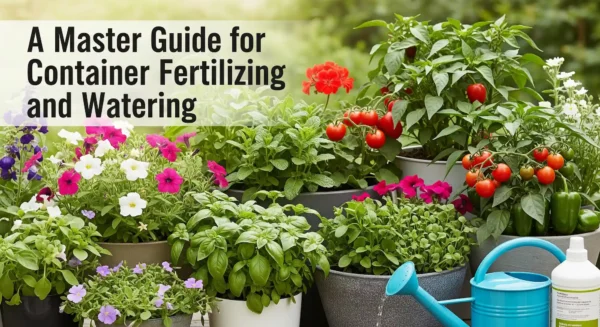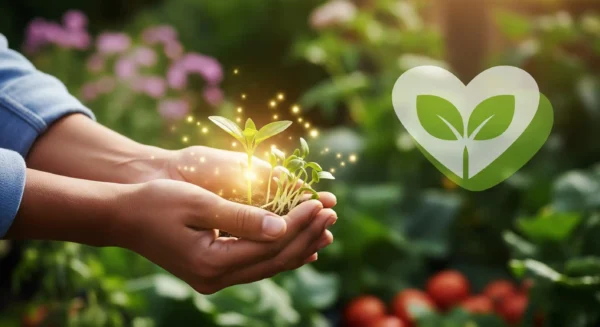The Complete Guide for Fruit Gardening Is Closer Than You Would Think.
Imagine walking into your backyard on a sunny summer morning to pick sun-ripened strawberries for breakfast, or grabbing a fresh, juicy apple right from the branch. Sounds to be a far-off dream. Well, I am here to inform you it is far closer than you would believe.
Indeed, even with limited space or a history of failing houseplants, good fruit planting is quite doable for home gardeners. From years of expertise, I can tell you the key is just about selecting the appropriate plants and knowing their basic needs—not some magical “green thumb”.
Together, we are about to start an amazing adventure over the realm of home grown fruit. We’ll look at the easiest berries with immediate returns, find reasonable fruit trees fit for any yard, and even discuss successful vines climbing their way to delight. By the time this book ends, you will not only have ideas but also have a clear, methodical plan to begin cultivating your own wonderful fruit. Let us begin right now.
The Foundation: Actions to Perform Before Beginning Any One Project
A little preparation goes a lot before we start to get messy. On this, I promise you. Usually built on a strong basis, the most effective and stress-free fruit gardens are also Spending some time now to evaluate your current environment will save you many problems down road.
Finding Your Garden’s Sweet Spot: Reading the Sun
Let us first start with light. Sun-worshippers nearly all fruit-producing plants are. Your fruit tastes so sweet because they turn that golden energy into sugars. Generally speaking, you want a place with at least six to eight hours of daily direct sunlight.
Spend a day working as a sun detective. Get a notebook and, beginning in the morning, check on your yard every few hours. Where does the sun make impact? Where from your house or that large oak tree are the shadows? Plot it out. This is a crucial first step for success since a sun-lower planted in a gloomy area is likely to be disappointing.
The Truth About Soil: Why It’s Not Just Dirt
We then have the ground itself. Not fond of “wet feet,” which is a gardener’s phrase for roots buried in damp soil, include fruit trees, shrubs, and vines They want soil with good drainage. An easy approach to verify this? Create a little hole, fill it with water, and track the disappearance times. You’re in good condition if it vanished in a few hours.
You might also perform a basic “squeeze test.” Snatch some moist soil and squeeze it. It might be overly dense if it forms a tight, clay-like ball without crumbling. It can drain too quickly if it breaks right away like sand. The perfect is a dark, crumbly soil that keeps shape yet breaks apart readily. If yours isn’t perfect, not cause for concern! Almost invariably adding rich, natural compost is the solution. It helps sandy soil retain moisture and breaks down clay really wonderfully.
Know Your Zone, Know Your Fruit: Gives Chill Hours Meaning
Particularly if you wish to establish fruit trees, this could be the most crucial piece of information I can offer you. Have “chill hours” ever come up? Though the idea is straightforward—that is, the total number of hours in winter where the temperature falls between 32 and 45°F (0-7°C)—it sounds complicated.
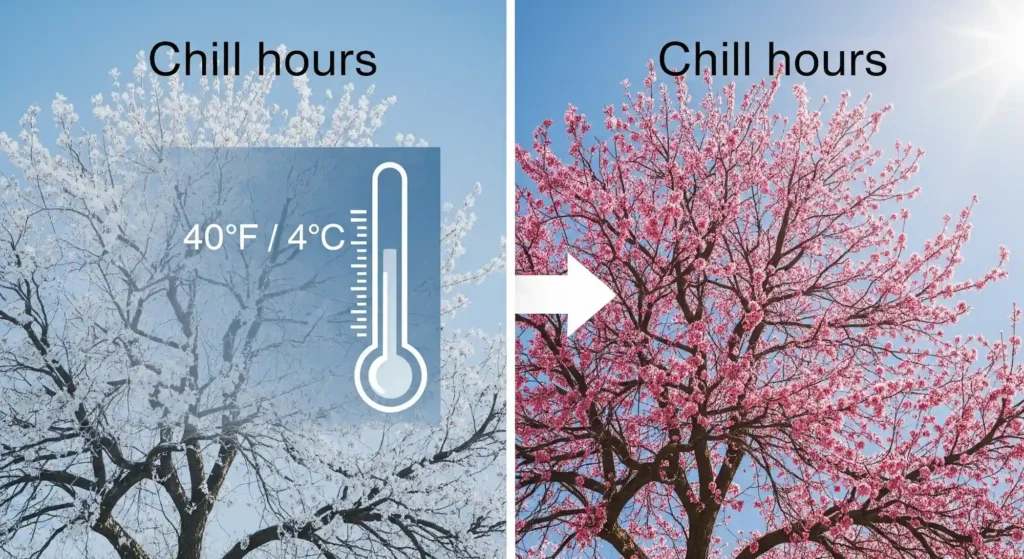
Why does this concern us? Fruit trees such as apples, peaches, and plums do, however, truly require some cold to “rest” before they can wake up and produce springtime blossoms and fruit. Consider it as obligatory winter sleep. Living in a warm area like Florida and planting an apple tree requiring 800 chill hours will probably never yield a single apple since it never gets enough sleep. The tag on a fruit tree purchased will indicate its cold hour need. Success depends on matching this to your particular environment.
The Keystones of Effective Home Fruit Growing
It’s time for the fun part— selecting your plants—when your site is ready. Though the choices can feel overwhelming, I’m here to guide you through them. From the ground up, let us dissect the top choices for novices.
The Quick Wins: Superior Berries for Quick, Yummy Results
Berries are the best choice if you wish the gratification of a harvest right in your first year. Perfect for gardeners who are just starting out, they are somewhat simple, immensely satisfying.
The ideal first fruit are strawberries. A homegrown strawberry is just the best. Because they can be planted practically anywhere—in a dedicated bed, a hanging basket, or a container on the patio—they are great for novices. Usually there are two varieties: Everbearing, which generates little flushes of fruit all year long, and June-bearing, which generates one big crop in early summer. Certain alpine strawberry types can be grown as a fragrant, fruiting groundcover, did you know? All summer long, they grow small, very delicious berries.
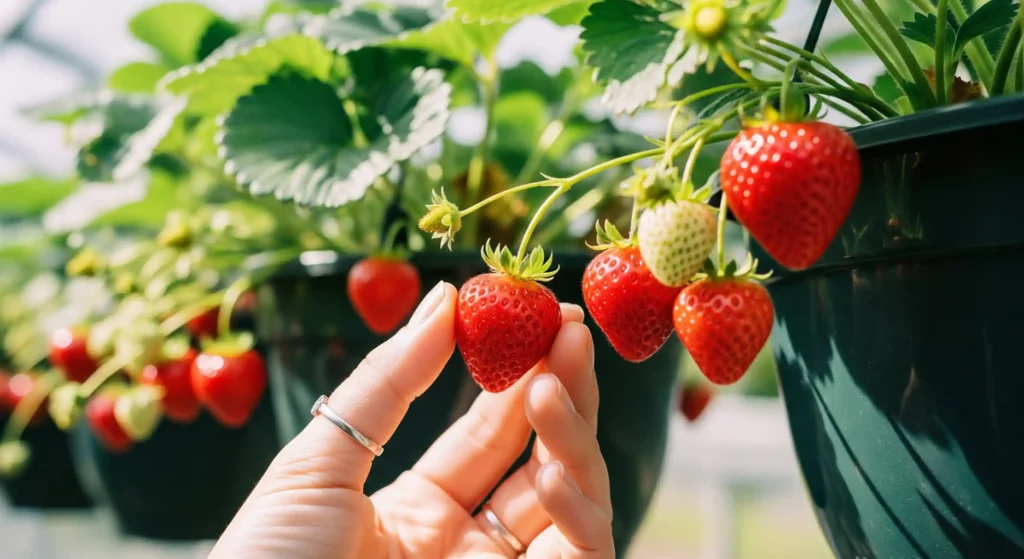
Blueberries: The key resides in the pH of the soil. Blueberries are loved by anybody not? Excellent, long-lived bushes are these ones. Their need for acidic soil is the one “secret” to raising them successfully. Though most garden soils are not naturally acidic enough, this should not terrify you! Additions like elemental sulfur or sphagnum peat moss will readily change your soil (just follow package guidelines). This assists the roots of the plant to receive all the nutrients required for growth and create those exquisite, dusky-blue jewels.
Blackberries and raspberries: pruning for an annual harvest These strong growers are vining berries known as brambles. Understanding their growth will help you to keep them healthy and not a tangled mess. They make canes; first-year canes are known as “primocanes,” and second-year canes as “floricanes.” While some types fruit on floricanes in the summer, others fruit on primocanes in the fall. Encouragement of a large, continuous harvest just requires a little smart trimming to eliminate the old, spent floricanes annually.
Tree-mendous rewards: selecting the correct fruit tree
Growing a fruit tree makes one feel like a real success. Search for trees cultivated on dwarf or semi-dwarf rootstocks before you buy. Often producing full-sized fruit on a far smaller tree, these have been grafted to remain at a reasonable scale for backyard gardens.
Apple and Pear: Value of a Pollination Partner Most apple and pear varieties depend on a companion, which is a vital reality. They are not self-pollinating, hence you must plant at least two distinct kinds close together so the bees may move pollen between them. Therefore, if you purchase a “Honeycrisp” apple, you will need another kind nearby, such as a “Granny Smith” or “Gala,” to have fruit.
Peaches and plums: the self-sufficient stone fruits Given most types are self-fertile, peaches and plums are great choices if you just have room for one tree. You just need one tree to have a complete crop of mouthwatering fruit! Though they are quite efficient, keep a look out for a frequent fungal problem known as peach leaf curl. It can be stopped before it occurs by a basic preventative treatment using a copper fungicide during the dormant season, late winter.
Reaching for the Sun: Growing Productful Vines
By using vertical space, vines can be a quite effective method to produce a lot of fruit in a limited area.
Grapes: More Than Simply Wine Local grapes are a joy whether you’re making jelly or eating fresh. The most crucial thing to understand is that from day one a strong trellis or arbor is non-negotiable. Grapes grow remarkably quickly; the secret to getting fruit is to extensively prune them every winter. Though it seems extreme, as I like to say, “You’re telling the vine where to put its energy”—into a smaller number of excellent grape clusters, not a jungle of leaves.
The Hardy Kiwi is a lesser-known star. Searching for something a bit different? Try hardy Kiwis! You may eat these smaller, smooth-skinned cousins of the fuzzy kiwis you see in the supermarket skin and all. These are rather active vines with great yield. The one flaw is For pollination, you will have to sow a male as well as a female plant.
Rapid Reference Fruit Selection Guide:
| Fruit Type | Sunlight’s Requirements | Foundation of Success | Ideal for Novators? |
|---|---|---|---|
| Strawberries. | six to eight plus hours. | Regular irrigation, excellent drainage | Yes, absolutely! |
| Berries blue in colour | 6–8+ hours | One absolutely needs acidic soil, low pH. | Yes, with soil preparation. |
| Raspberries | six to eight plus hours. | Pruning once a year helps to support | Sure. |
| Pears or apples | 8 + hours | needs a different type for pollination. | Moderate |
| Plumas/peaches | more than eight hours | Most are self-fertile with decent air flow. | Yes. |
| Graphs | Eight plus hours | strong trellis and extensive winter pruning | Consistent |
Modern Care for a Rich Harvest
Once your plants are in the ground, a little careful upkeep will make a decent crop outstanding. Be not scared! Let’s go over the three most crucial tactics that will help you feel like an expert.
Pruning Fruit Trees for More Not More Branches
Though it’s necessary, pruning is most likely the chore young fruit producers dread most. The primary objectives are to remove any dead or broken wood, open the tree to sunlight and air circulation—which helps to prevent disease—and inspire the tree to produce fruit rather than too much foliage development. Most significant pruning is done late winter, during tree dormancy.
A thinning cut—where you remove a whole branch back to its point of origin—and a heading cut—where you shorten a branch—are the two fundamental cuts. For fruit, you will largely be shaping an open, vase-like form with diminishing cuts.
See our whole tutorial on pruning fruit trees for maximum yield for a deep dive.
The Puzzle of Pollination: Deciphering Fruit Set
Though we discussed this earlier, it’s worth revisiting. nor a pollination, nor fruit! Remember to find out whether the fruit you choose requires a mate or is self-polling. Still, you need the pollinators even with the correct trees! For most of us, our dear bees handle this task. Planting other flowers they love, such lavender, borage, and coneflowers, will aid them; avoid spraying pesticides while your trees are in bloom.
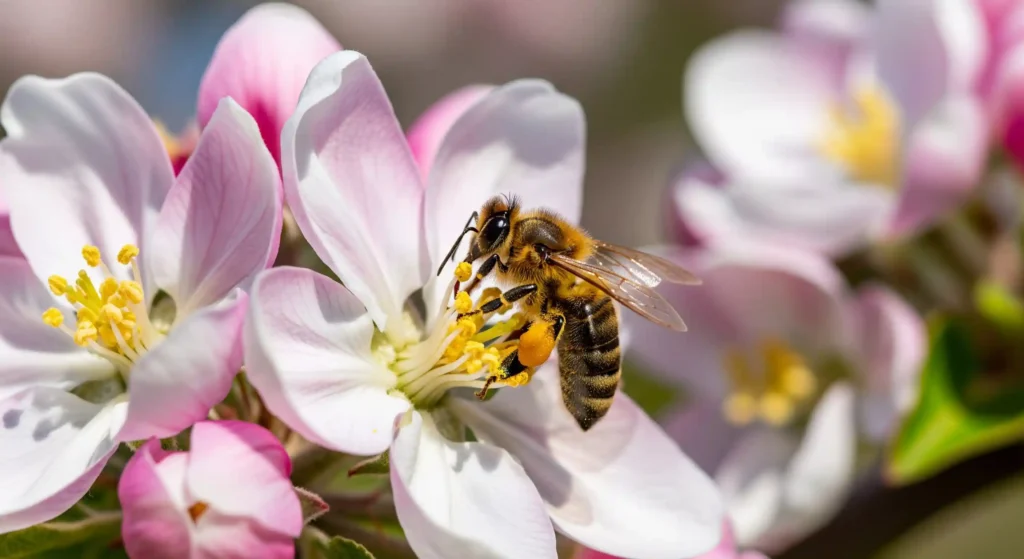
Read our ideas on Attracting Pollinators to Your Garden to help your buzzing buddies.
Fighting the Bad Guys: Typical Pests of Fruit Trees & Berry Bushes
Although it can be depressing to see pests in your garden, an integrated strategy will help to control them. A solid offense is a good defense; healthy, unstressed plants are less likely to attract pests and illnesses. Start with the mildest solutions for typical problems including aphids on your apple tree’s fresh growth or Japanese beetles on your raspberries. Many times, a forceful water shower will knock them down. If you require more firepower, organic solutions far safer for the environment and for our pollinating friends are insecticidal soap and neem oil.
See something suspicious? Check it against our guide on diagnosing common plant problems.
Frequently asked questions about fruit gardening answered here.
Still have any doubts? You are not solitary! These responses address some of the most often asked questions by prospective fruit gardeners.
In a home garden, which fruits are most likely to be simplest to grow?
I usually advise strawberries for the absolute novice. Growing in any sunny location, even a container, they yield a wonderful reward in your first season. Excellent low-maintenance possibilities are also raspberries and bush cherries.
How should I prune fruit trees to produce more?
Pruning in late winter will help to produce an open structure allowing sunlight and air to reach every section of the tree. Target eliminating branches that cross, grow inward, or crowd others. This guides the tree’s energy toward generating superior fruit rather than thick, leafy development.
Does pollination call for two fruit trees?
It varies according to the fruit! Most apples, pears, and sweet cherries need a second, distinct kind close by to generate fruit. But most peaches, plums, apricots, and sour cherries are self-fertile, therefore you just need one. Always review the tag on the plant before making purchase!
Common invaders of berry bushes are what?
Look for Japanese beetles, which can skeletonize leaves, and a little fruit fly called the Spotted Wing Drosophila (SWD), which can spoil maturing fruit, for berries. Since birds love berries so much, you might want to think about utilizing netting when your fruit begins to ripen.
In my yard, how can I raise grapes?
Full sun—the more, the better—and a very strong trellis, fence, or arbor to sustain their growth are the two most vital elements for grapes. To be fruitful, they also need vigorous winter yearly pruning.
Chill hours for fruit trees?
Chill hours are the total number of hours a fruit tree must be exposed to low temperatures—usually between 32 to 45°F—during the winter to break dormancy and produce fruit in the spring. Select a flavor with a cool hour need that fits your environment.
Your Trip toward a Homegrown Harvest Begins Right Now
You’ve done it! You now possess the fundamental skills need to boldly walk out into your yard. Effective fruit gardening is about knowledge, a little bit of planning, and the delight of relating with your food; it is not about having a “green thumb” or some natural, mystical ability. It’s a path of knowledge about your site, soil, and the particular requirements of every plant.
You now carry the road map. You really are within your grasp the sensory delight of choosing your own fruit—warm from the sun, brimming with taste. begin with one plant. One ideal peach tree or one potful of strawberries. Go through the fulfilling trip for yourself. Your future self will appreciate the great, wonderful success.



